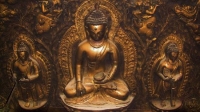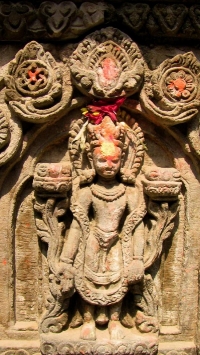The true history of Ayurveda starts in the time of the Vedas, the ancient Holy Books of the Aryans (“noble ones”). Hindu mythology tells us that Lord Brahma, the creator of the world, transmitted the knowledge of Ayurveda to mankind. The four Vedas are called Rig Veda, Yajur Veda, Sama Veda and Atharva Veda. They were written about 3-5 thousand years ago. All the Vedas contain medical knowledge based upon the principles of Ayurveda, especially the Atharva Veda.
 It was well known to the ancient peoples of the East that rishis and munis existed, learned sages and saints who devoted their life to understanding the realities of the world (the word rishi and muni are interchangeable, but a rishi would be the most spiritually advanced of these two words for sage). Aryavarta, the land of the Aryans which covers the wide surrounding area of the Himalayas, is the native home of the rishis and munis. The surrounding area of the Himalayas in the present political landscape includes the countries of Nepal, India, Pakistan, Bhutan, and Bangladesh.
It was well known to the ancient peoples of the East that rishis and munis existed, learned sages and saints who devoted their life to understanding the realities of the world (the word rishi and muni are interchangeable, but a rishi would be the most spiritually advanced of these two words for sage). Aryavarta, the land of the Aryans which covers the wide surrounding area of the Himalayas, is the native home of the rishis and munis. The surrounding area of the Himalayas in the present political landscape includes the countries of Nepal, India, Pakistan, Bhutan, and Bangladesh.
The ancient civilization of these countries was strongly influenced by the unique intellectual contributions of these holy sages. The hymns, liturgical formulas and medical knowledge found in the Vedas were the contributions of various rishis and munis. The sages realized that sickness was a major impediment to the search for liberation, and so many of them became vaidyas to help their people. Vaidya, the Sanskrit word for physician, is derived from the root word for wisdom.
About seven hundred years BC there was a renowned rishi called Bharadwaja, who was known as the leading vaidya of his time in the land of Aryavarta. There were many stories about him and his medical skills. Atreya Punarvasu – the medical sage who is the source of the most important classic of Ayurveda, the Charaka Samhita – tells us that Bharadwaja was the first medical teacher of all subsequent rishis and munis. He learned Ayurveda directly from Lord Indra, the king of the gods. Indra had learned Ayurveda from the Aswinis, who were known as practitioner physicians to the gods. Prajapati was the teacher of the Aswinis and he studied Ayurveda from the Lord Brahma, the creator of the world.
Today’s historians cannot understand who these god-like characters actually were. The Vedas talk in detail about Indra, the Aswinis, Prajapati etc. and give many details about their exploits and personalities. But from a historical perspective their roles can never be totally clear, because there is no authentic proof that they were real persons or even characters based upon authentic historical personages. The implications of the story of Ayurveda’s spiritual beginnings and the transmission of knowledge are extremely thought provoking, because the writers of that time depict it (and clearly believe it to be) the result of direct communications between real celestial beings and the great sages.
The Great Medical Conference
 The historical record of Ayurveda begins with a medical conference in the Himalayan Mountains described in the collection (samhita) of medical writings called the Charaka Samhita. The writer, Atreya Punarvasu, was one of the devoted students of Bharadwaja. He tells us that a large and well-attended medical conference of veteran rishis and munis was held under the chairmanship of Bharadwaja in the valley of the Himalayas. The main aim of this conference was to share medical knowledge and to encourage the attending scholars to compile the medical knowledge gained by different peoples of the region, knowledge that had been passed down, mostly orally, from generation to generation. This stream of Ayurvedic medical knowledge was considered eternal, because it was known by them to have been there since the beginning of time. However, the participants also knew that there were no authentic and complete texts of Ayurveda available for study. For this reason the writing of texts became the focus of the conference.
The historical record of Ayurveda begins with a medical conference in the Himalayan Mountains described in the collection (samhita) of medical writings called the Charaka Samhita. The writer, Atreya Punarvasu, was one of the devoted students of Bharadwaja. He tells us that a large and well-attended medical conference of veteran rishis and munis was held under the chairmanship of Bharadwaja in the valley of the Himalayas. The main aim of this conference was to share medical knowledge and to encourage the attending scholars to compile the medical knowledge gained by different peoples of the region, knowledge that had been passed down, mostly orally, from generation to generation. This stream of Ayurvedic medical knowledge was considered eternal, because it was known by them to have been there since the beginning of time. However, the participants also knew that there were no authentic and complete texts of Ayurveda available for study. For this reason the writing of texts became the focus of the conference.
This historic conference was a milestone in the history of medicine. The task of compiling the medical knowledge was very difficult, because many scholars who knew various aspects of Ayurvedic medicine lived and worked throughout different parts of the Eastern world. Travel and communication in those days was very difficult. Nonetheless, the participants of the conference overcame these difficulties. They arrived from many distant points and stayed together for a long period of time. The conference is estimated to have lasted about three years. The participants engaged in long and complex discussions and debates, and formed committees to compile full texts about the different subjects of Ayurveda. The attending scholars produced all the Charaka Samhita, the text of internal medicine, the Susruta Samhita, the text of surgery, and the Kashyapa Samhita, the text of pediatrics, and many others.
0 Responses to “The Historical Background of Ayurveda”